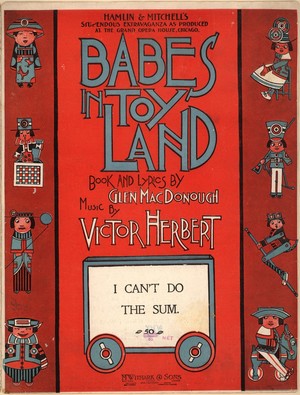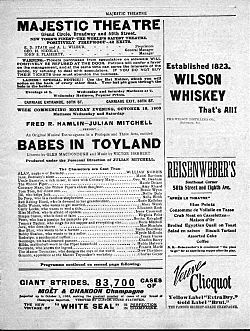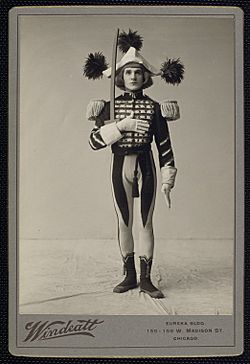Babes in Toyland (operetta) facts for kids
Quick facts for kids Babes in Toyland |
|
|---|---|

Sheet music cover
|
|
| Music | Victor Herbert |
| Lyrics | Glen MacDonough |
| Book | Glen MacDonough |
| Productions | |
Babes in Toyland is an operetta composed by Victor Herbert with a libretto by Glen MacDonough, which wove together various characters from Mother Goose nursery rhymes into a Christmas-themed musical extravaganza. Following the extraordinary success of their stage musical The Wizard of Oz, which was produced in New York beginning in January 1903, producer Fred R. Hamlin and director Julian Mitchell hoped to create more family musicals. MacDonough had helped Mitchell with revisions to the Oz libretto by L. Frank Baum. Mitchell and MacDonough persuaded Victor Herbert to join the production. Babes in Toyland features some of Herbert's most famous songs – among them "Toyland", "March of the Toys", "Go to Sleep, Slumber Deep", and "I Can't Do the Sum". The theme song "Toyland", and the most famous instrumental piece from the operetta, "March of the Toys", occasionally show up on Christmas compilations.
The original production opened at the Chicago Grand Opera house in June 1903, produced by Hamlin and directed by Mitchell, and toured to several East Coast cities before opening in New York in October 1903 and ran for 192 performances. This was followed by many successful tours and revivals. The piece was so popular that it spawned other "fairy-tale" shows over the next decade.
Contents
Productions
After a three-month tryout beginning on June 17, 1903, at the Grand Opera House in Chicago, followed by a tour to several East Coast cities, the original New York production opened on October 13, 1903, at the Majestic Theatre at Columbus Circle in Manhattan (where The Wizard of Oz had played) and closed after 192 performances on March 19, 1904. It was produced by Fred R. Hamlin and directed by Julian Mitchell. Large audiences were drawn to the musical by the spectacular settings and opulent sets (e.g., the Floral Palace of the Moth Queen, the Garden of Contrary Mary) of Toyland. The sets were designed by John H. Young and Homer Emens, with costumes designed by Caroline Siedle. In September 1904, two tours went on the road. The first-class one played a three-week return engagement beginning on January 2, 1905, at the Majestic, and then continuing its tour, kept the scenic effects and much of the original cast, making stops in major cities for extended periods of time. The second-class tour with a reduced cast and orchestra was streamlined for short stays on the road.
The operetta has been staged nine times at The Muny, beginning in 1920.
A Broadway revival opened on December 23, 1929, at Jolson's 59th Street Theatre, closing on January 11, 1930. It was directed by Milton Aborn. Another Broadway revival opened on December 20, 1930, at the Imperial Theatre, closing in January 1931. It was directed by Aborn and choreographed by Virginie Mauret.
A new book and lyrics for the show were written for the off-Broadway Light Opera of Manhattan (LOOM) in 1975 by Alice Hammerstein Mathias (the daughter of Oscar Hammerstein II) and the company's director-producer William Mount-Burke. LOOM played this operetta as a Christmas show for six to eight weeks each year thereafter for 13 seasons with considerable success, and this version of the book and lyrics has since been used by various companies, including Troupe America and others. The ensemble becomes a mechanical militia of toys for the "March of the Toys", and children from the audience are brought up to help "wind-up" the toy dancers.
In 2003, in celebration of the 100th anniversary of the operetta, Hampton, Virginia–based Rainbow Puppet Productions created a touring puppet version of the show entitled "Toyland!" The new script was adapted by David Messick Jr. Prerecorded puppet voices were created, featuring Mickey Rooney as the Master Toymaker and his wife Jan Rooney as Mother Goose. The program has toured annually since that time. In this version, Little Bo Peep has lost her sheep, and her evil Uncle Barnaby is to blame. She travels through the Spider Forest to seek help from the kind Master Toymaker.
Characters
- Alan, nephew of Barnaby
- Jane, his sister
- Uncle Barnaby, a rich miser in love with Contrary Mary
- The Widow Piper, a widow with 14 children
- Tom Tom, her eldest son
- Contrary Mary, her eldest daughter
- Little Bo-Peep, who is a careless shepherdess
- Peter, who has a passion for pumpkin pie
- Tommy Tucker, who sings for his supper and everything else
- Sallie Waters, who wants to get married
- Jack and Jill, Little Miss Muffet, Curly Locks, Red Riding Hood, Bobby Shaftoe, Simple Simon and Boy Blue
- Hilda, the Widow Piper's maid
- The Master Toymaker, who designs toys of the world
- Grumio, apprentice to the Master Toymaker
- Gonzorgo and Roderigo, Barnaby's hired ruffians
- Inspector Marmaduke, of the Toyland Police
- The Spirit of the Pine and the Spirit of the Oak
- Gertrude, a peasant
- The Moth Queen, the Giant Spider and the Brown Bear
Dandies, Flower Girls, French Dolls, Punches, Dutch Dolls, Toy Soldiers, Trumpeters, Drummers, Widows
Musical numbers
|
|
Recordings
Herbert's Victor Herbert Orchestra recorded selections from Babes in Toyland in 1911–1912 for the Victor Talking Machine Company as single releases, including "March of the Toys", "The Toymaker's Shop" and "The Military Ball". Decca Records recorded ten selections from the score (on five 10-inch 78-RPM records) in 1944. The recording featured Kenny Baker and Karen Kemple with a chorus and orchestra conducted by Alexander Smallens. This album was reissued on a 10-inch LP in 1949, and by reducing the selections from ten to six, Decca re-released it on one side of a 12-inch LP (The Red Mill was on the reverse) in 1957. Decca Broadway reissued the complete album on CD (again paired with The Red Mill) in 2002.
The Walt Disney film version, released in 1961, was given two recordings released in the same year. The first was a cover version featuring only Ed Wynn and Ann Jillian from the film, supported by a cast of singers unidentified on the album. This version was released by Disneyland Records. The second used the original vocal tracks from the soundtrack of the film; however, the musical accompaniments and choral arrangements were not those heard in the film, but those heard on the cover version. This album was released on Buena Vista Records and features Wynn, Jillian, Ray Bolger, Henry Calvin, Kevin Corcoran, Annette Funicello and Tommy Sands. Neither one of these albums has been issued on CD.
A stereo recording was made by Reader's Digest for their 1962 album Treasury of Great Operettas. Each of the 24 operettas in the set is condensed to fill one LP side. The recording was conducted by Lehman Engel. A 1963 recording of several of the songs was released together with numbers from The Wizard of Oz (1963 MGM Studio Cast). A compilation album was released on CD in 1997. The Reader's Digest recording was released on CD in 2012.
A recording of the complete score, with the original orchestrations restored and conducted by John McGlinn with the London Sinfonietta and the London Voices, was made in 2001. It featured Hugh Panaro as Alan, Korliss Uecker as Jane, Ian Richardson as Barnaby, Valerian Ruminski as Gonzorgo, Elizabeth Futral as Contrary Mary, Rebecca Caine as Tom-Tom and Ian McKellen as the Master Toymaker. It has never been released. A cast recording of the 2003 production of "Toyland!" was released in 2007, featuring the voice of Mickey Rooney as the Master Toymaker. His wife, Jan Rooney, plays Mother Goose.
Adaptations
Children's book
A 1904 children's book of the same name by Glen MacDonough and Anna Alice Chapin, with illustrations by Ethel Franklin Betts, is based on the operetta.
Films
Laurel and Hardy's 1934 film version of Babes in Toyland (reissued as March of the Wooden Soldiers) includes only five of Herbert's songs and almost none of the original book. It does include many of the original characters, although Laurel and Hardy's were new to the story. It features Felix Knight as Tom-Tom, Charlotte Henry as Little Bo-Peep and Henry Brandon as Silas Barnaby. It does not interpolate songs by any other composers.
Walt Disney's Technicolor 1961 film production starred Bolger, Sands, Funicello, Jillian, Calvin, Gene Sheldon and Ed Wynn. This had a heavily revised plot and new lyrics, but much of the Herbert music was included, although often in altered tempi, and many of the original characters still appeared in the story. A stage version of Babes in Toyland, with a plotline similar to the Disney film has a book by Rebecca Ryland and music and lyrics by Bill Francoeur.
An animated film version, with a new plot and only one of the original songs, was released in 1997 by Metro-Goldwyn-Mayer featuring the voices of Christopher Plummer, James Belushi, Bronson Pinchot and Lacey Chabert.
Television
Between 1950 and 1960, there were at least three television versions of Babes in Toyland, all broadcast during the Christmas season. A 1950 version starred Edith Fellows, James Gregory and Robert Weede; Dennis King played a new villain called Dr. Electron. A 1954 adaptation, restaged in 1955, starred Jo Sullivan (1954) and Barbara Cook (1955) as Jane, and featured Wally Cox as Grumio, Dave Garroway as Santa, Dennis Day as Tommy, Karin Wolfe as Ann (Jane's little sister) and Jack E. Leonard as Barnaby. Bambi Linn was a featured dancer, and the production incorporated the Bil Baird marionettes.
A 1960 adaptation for television featured Shirley Temple as the old gypsy Floretta, Angela Cartwright as Jane, and Jonathan Winters as Barnaby. It was shown as an episode on the anthology series The Shirley Temple Show. It is the only screen or television version that retained the operetta's primary plot (the orphans' escape from their cruel uncle), but it omits the secondary plot involving the nursery-rhyme characters. Barnaby and the Toymaker survive at the end, although Barnaby (who is more a comic villain than the dangerous original character) is punished by the law. The Toymaker is portrayed as a kindly old man, and Floretta ends up helping the children and turning against Barnaby.
A 1986 made for television version featured Drew Barrymore, Pat Morita and Keanu Reeves, only two songs from the Victor Herbert score, a new plot, and many new songs by Leslie Bricusse.
See also
- Parade of the Wooden Soldiers



